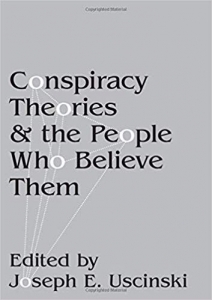In Conspiracy Theories and the People Who Believe Them, Joseph Uscinski presents a collection that brings together contributors to offer a wide-ranging take on conspiracy theories, examining them as historical phenomena, psychological quirks, expressions of power relations and political instruments. While this is an interesting and expansive volume, writes Max Budra, it does not fully grapple with the conundrum posed by conspiracy theories that succeed in capturing the epistemological authorities.
Conspiracy Theories and the People Who Believe Them. Joseph Uscinski (ed.). Oxford University Press. 2018.
The greatest challenge in studying conspiracy theories—a task likened to trying to housebreak a chicken in a recent New Yorker article—may well be simply defining what a ‘conspiracy theory’ is in the first place. The term encompasses a dizzying array of phenomena, from contrails to Elvis Presley’s mortality, and cuts across several academic disciplines. No surprise, then, that Conspiracy Theories and the People Who Believe Them, a recently published collection of essays edited by Joseph Uscinski, takes an expansive view of the topic. The essays examine conspiracy theories as historical phenomena, psychological quirks, expressions of power relations and as political instruments. Understandably, many of the essays fall back on simple description—the authors’ incredulity can be read between the lines.
In what may be a sign of the difficulty of the task, a definition of ‘conspiracy theory’ is only offered by Uscinski roughly 50 pages into the book. A conspiracy theory is, as he defines it:
an explanation of past, ongoing, or future events or circumstances that cites as a main causal factor a small group of powerful persons […] acting in secret for their own benefit and against the common good (48).
Crucially, Uscinski and many of his contributors then go on to note that such theories usually conflict with the account of the so-called epistemological authorities (48, see also Juha Raikka and Lee Basham, 179). Conspiracy theories are thus framed by Matthew D. Atkinson and Darin Dewett as fringe phenomena, ‘tools for the weak’ (122).
This makes intuitive sense. The typical picture of a conspiracy theorist is of a marginal figure engaged in some kind of hopeless protest, waving a homemade sign and shouting incoherent warnings outside the White House. Conspiracy theorists are seen as powerless, and this perception shapes how conspiracy theories are studied. Indeed, it seems to have led to a situation in which conspiracy theorists are seen as powerless by definition. This thinking underpins the arguments in this collection that treat conspiracy theories as a kind of folk knowledge, or as a mutation of the common person’s democratic vigilance, as found in the chapters by Alfred Moore (119), Steven M. Smallpage (192) and Michael J. Wood and Karen M. Douglas (251).
The consequence of defining conspiracy theorists as powerless is that doing so distorts the entire study of conspiracy theories. Since conspiracy theorists and their theories exist on the fringes of power, the threat they pose, according to several contributors to Conspiracy Theories, is that they can corrode societal trust and governmental capacity, and that they can be used to upend the status quo by a system’s ‘losers’ (Atkinson and Dewett, 125).
 Image Credit: (mdherren CCO)
Image Credit: (mdherren CCO)
This may be true, but it leaves the reader with the uncomfortable feeling that something is being missed: that only half the problem is being examined. Conspiracy theories are not just for the powerless. Joseph Stalin, for instance, may not have believed the rationale behind the terror he unleashed in the 1930s, but most good Bolsheviks did, at least initially. In the United States, J. Edgar Hoover and the FBI genuinely seem to have believed that civil rights activists were the tools of the Communist International. Both cases are textbook examples of conspiracy theorising, according to Uscinski’s own definition.
Yet despite its wide range, Conspiracy Theories does not discuss the former case; meanwhile, the FBI’s actions are positioned as instigators of other conspiracy theories, but not as conspiracy theories themselves.This despite the fact that the respective impacts of both were arguably greater than, say, the impact of the debate over water fluoridation in Portland, Oregon, which is discussed by Uscinski (11). A counterfactual might explain why neither case, or indeed any similar case, is analysed as an example of conspiracy theorising. What if, instead of Hoover and the FBI imagining that African Americans were engaged in conspiracy, it was the other way around? Luckily, you don’t have to imagine: an essay in Conspiracy Theories by Martin Orr and Ginna Husting looks at how African American concerns over the actions of the American government are routinely dismissed as ‘conspiracy theories’ (85-89). One is left with the impression that if the powerful are doing it, it’s not conspiracy theorising.
This impression is reinforced by the section of Conspiracy Theories containing essays discussing conspiracy theorising outside of the United States: this section is where the book does discuss the use of conspiracy theories by elites. The word ‘use’ is important here, as is the word ‘prefer’ in the title of one of the essays, ‘Why the Powerful (in Weak States) Prefer Conspiracy Theories’. The word ‘prefer’ arguably implies choice, not true belief. The chapter discusses Russia, Turkey and Afghanistan, and explains that politicians in those countries are ‘prone to secrecy, infighting, and intrigue as a style of politics’, which makes ‘conspiracy an attractive—and often effective—rhetorical strategy’ (Scott Radnitz, 348). Conspiracy theories, the essay explains, are therefore a ‘useful tool’ for politicians in those countries (349). This perfectly captures a key flaw with so many discussions of conspiracy theories, and indeed with Conspiracy Theories. Conspiracy theories are treated as the domain of the marginal, and as soon as the elites engage in conspiracy theorising, it is no longer treated as such, but rather as a means to an end: a tool cynically used by disbelieving elites to control the credulous masses. The idea that the elites may actually believe the conspiracy theories they propagate is too often overlooked.
This can also be seen in the essays discussing conspiracy theories and elites in the Russian Federation, Turkey and Argentina. While interesting and detailed in their own right and helpful in understanding the power of demagoguery, they reinforce the notion that elites use conspiracy theorising without actually believing in it. In Russia, conspiracy theories about ‘the West’ are used as the basis for ‘political campaigns aimed at legitimising the regime’ (Ilya Yablokov, 369). Meanwhile, an ‘instrumental rationale’ is apparent in discussions of the deep state conspiracy in the Turkish parliament (Türkay Salim Nefes, 392). Argentinian presidents, finally, have resorted to conspiracy theory as a ‘mechanism for shoring up their authority’; if used properly, conspiracy theory discourse has ‘multilayered uses within strategic and political communications’ (Tanya Filer, 396, 404). The indulgence of conspiracy theories by elites is thus treated as a stratagem. Elites do not seem to fall prey to conspiracy theorising. Rather, they ‘use’ it as a ‘tool’ to further their own ends.
As such, while Conspiracy Theories is an interesting, expansive study of conspiracy theories, it is ultimately incomplete. It is akin to a book on revolutions that only studies revolutions that never got off the ground. A successful conspiracy theory is one that is no longer treated as a conspiracy theory at all, but is rather accepted as the truth: one that moves from the minority to the majority, capturing the epistemological authorities. Thus, by defining conspiracy theorising as a fringe, minority phenomenon or as a tool of control used by the elites, we risk overlooking those conspiracy theories that actually do succeed. We are thus left with no tools with which to analyse that success, despite its potentially grave consequences.
Hopefully this oversight will be corrected in future editions, and will become more of a focus for the entire field of conspiracy theory studies. There is good reason to believe this may happen soon. After all, as Uscinski himself acknowledges in the Introduction, the conspiracy theorist has made it past the White House fence. He now sits in the Oval Office.
Note: This review was first published on the LSE Review of Books blog. It was temporarily taken down on 20 June 2019 and reposted on 2 October 2019 following amendments made to more accurately reflect the contents of the volume in response to concerns expressed by the book’s editor.
Max Budra is a graduate of the LSE Department of International Relations, and holds an MSc in International Relations, as well as a BA in Political Science from Simon Fraser University. His main research interest is the ideology of American foreign policy. Max currently works in the alternative investment management industry; the views expressed in this article are his own.


 Find this book:
Find this book: 





I can see what the reviewer means but I guess a partial defence of the scope of the book would be that most people when asked about conspiracy theories would think of the eccentric and irrational whether it is giant lizards ruling the world, UFOs, flat-earthers or that the UN or US federal government are seeking to establish a world government. We might also add anti-vaxers and climate change deniers, albeit they are less deranged and have wider support The problem, as the reviewer identifies, is that this focus may not have been made sufficiently clear at the start. Conspiracy theories adopted by governments and political parties feel rather different in nature and would probably require a separate book.